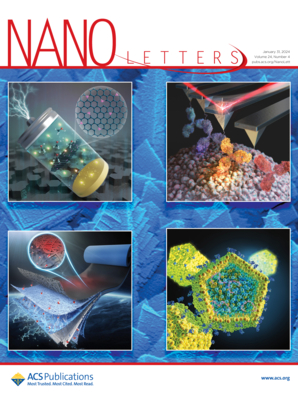眼见为实:银纳米立方体在水系统中生长过程中表面如何变化
IF 9.6
1区 材料科学
Q1 CHEMISTRY, MULTIDISCIPLINARY
引用次数: 0
摘要
种子介导的生长包括十六烷基三甲基氯化铵(CTAC)、三氟乙酸银(CF3COOAg)、抗坏血酸(H2Asc)和在水介质中覆盖聚乙烯吡罗烷酮(PVP)的银种子,是一种可调节尺寸的银纳米立方体的有效途径。然而,诸如表面变化之类的机械细节仍然难以捉摸。在这里,我们通过利用表面增强拉曼散射(SERS)的高灵敏度和水相容性来解决这个问题。我们的研究结果表明,CTAC的加入导致PVP和氯化物之间的配体交换,而CF3COOAg的进一步引入导致AgCl在Ag种子上的沉积。随后引入的H2Asc由于电子转移而增加了种子表面的电子密度,这表现在AgCl和CTA+的SERS信号迅速而明显的增强。来自H2Asc的电子也使还原直接将与Ag接触的AgCl转化为Ag原子,并将种子扩大到纳米立方体。本文章由计算机程序翻译,如有差异,请以英文原文为准。

Seeing Is Believing: How Does the Surface of Silver Nanocubes Change during Their Growth in an Aqueous System
The seed-mediated growth involving cetyltrimethylammonium chloride (CTAC), silver trifluoroacetate (CF3COOAg), ascorbic acid (H2Asc), and Ag seeds covered by poly(vinylpyrrolidone) (PVP) in aqueous medium is a robust route to Ag nanocubes with tunable sizes. However, mechanistic details such as changes to the surface remain elusive. Herein, we address this issue by leveraging the high sensitivity and water compatibility of surface-enhanced Raman scattering (SERS). Our results reveal that the addition of CTAC results in ligand exchange between PVP and chloride and the further introduction of CF3COOAg leads to the deposition of AgCl on Ag seeds. The H2Asc subsequently introduced increases the electron density on the surface of the seeds due to electron transfer, as manifested by rapid and pronounced enhancement of the SERS signals from AgCl and CTA+. The electrons from H2Asc also enable reduction to directly transform AgCl in contact with Ag into Ag atoms and enlarge the seeds into nanocubes.
求助全文
通过发布文献求助,成功后即可免费获取论文全文。
去求助
来源期刊

Nano Letters
工程技术-材料科学:综合
CiteScore
16.80
自引率
2.80%
发文量
1182
审稿时长
1.4 months
期刊介绍:
Nano Letters serves as a dynamic platform for promptly disseminating original results in fundamental, applied, and emerging research across all facets of nanoscience and nanotechnology. A pivotal criterion for inclusion within Nano Letters is the convergence of at least two different areas or disciplines, ensuring a rich interdisciplinary scope. The journal is dedicated to fostering exploration in diverse areas, including:
- Experimental and theoretical findings on physical, chemical, and biological phenomena at the nanoscale
- Synthesis, characterization, and processing of organic, inorganic, polymer, and hybrid nanomaterials through physical, chemical, and biological methodologies
- Modeling and simulation of synthetic, assembly, and interaction processes
- Realization of integrated nanostructures and nano-engineered devices exhibiting advanced performance
- Applications of nanoscale materials in living and environmental systems
Nano Letters is committed to advancing and showcasing groundbreaking research that intersects various domains, fostering innovation and collaboration in the ever-evolving field of nanoscience and nanotechnology.
 求助内容:
求助内容: 应助结果提醒方式:
应助结果提醒方式:


